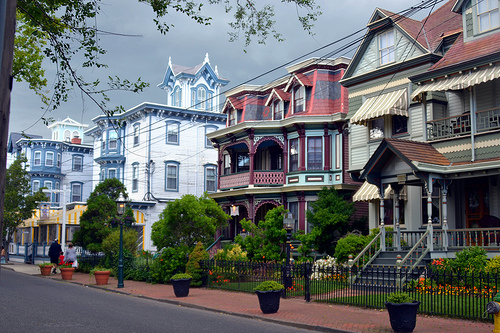Oh how we love those old classic homes in the older parts of the city. Big wrap-around porches, wonderful craftsman or Victorian style trim and beautiful, one-of-a-kind windows. Walking through those older neighborhoods reminds us of childhood days long gone, and a kind of America that seems so far away from the information and technology age we live in today. They just don't build 'em like that anymore.

Image by Tobyotter via flickr.com
But if you're dreaming of buying one of those old properties in a historical area, you'd better check out the local building and renovation rules before you do. Many people who buy in historic neighborhoods have awakened from their dream to discover a nightmare of rules and requirements that govern properties located in 'historic districts'.
Buyers often think about purchasing a historic property with the intention of renovating the original structure and bringing it up to modern standards. You'd think that everything would be OK as long as you are improving on that old building that may be dilapidated and about to fall in on itself. But when you are talking about old properties with historic significance which are located in an official historic district, you need to do your homework ahead of time to make sure that you'll be allowed to renovate the structure according to your vision. Otherwise, you could end up making sure that the vision of the historical society is satisfied instead. And when it comes to keeping a historical society satisfied, sometimes, money is no object ' especially when it is YOUR money that must be spent to keep them happy.
In most historic districts, there are rules in place that require property owners to keep the original building design and footprint. The property may have been altered 10 times over the years, but modern historical societies put great emphasis on how the original neighborhood looked.
When you buy in one of these areas, you probably won't be allowed to make any major improvements that were not part of the original structure. In other words, if you bought a property that was originally a livery stable back in the 1800's the historical society may expect you to keep the original livery stable design when making improvements. This actually happened to a property owner in Atlanta, Georgia's historic Cabbagetown neighborhood.
I've had my own run-in with a historical society, over a renovation of a property that was also located in a historic district. Back in 2004 our investment company purchased a run down old house in a neighborhood that dated back to the early 1900's. The front porch was missing, there was no driveway, the house had been used as a rental property for years, and was in very poor condition.
As real estate investors our plan was to renovate the home and sell it to an owner occupant. The home would look better than ever with a new driveway, and we thought that replacing the missing front porch would add some much needed curb appeal. The house was an eyesore, and our renovation was sure to improve the surrounding property values. We never realized ahead of time what a hassle this project would prove to be.
Our first mistake was that we had not realized that we were in a historic district, governed by a historical society. We'd renovated homes all over the area, and most of them in older neighborhoods. But this time, we'd chosen a property that was actually inside a historic district.
Once we closed on the property, our contractor went to pull permits to begin the renovation. It was then that he discovered that the renovation plans would have to be approved by the local historical society.
The society initially refused to approve the plans because an old photograph of the house showed a totally different style of front porch than the one we had originally planned. And, because the home had an outdated bathroom that had been added well after the property was constructed, we were planning to move some walls around which would affect the front exterior wall of the property. The society demanded that we replace the original porch exactly as it looked in the old photo, instead of what we had in mind, and wanted us to change our plans for altering the walls.
Long story short, the requirements of the society, combined with months of delays necessary to get their approval of new plans resulted in us losing money on the project. We did finally finish the renovation and sell the house, but at a much higher cost than we originally budgeted, with a much longer time frame than we had originally planned.
So, when you dream of buying a victorian era classic, make sure you know whether the property is in a historic district before you buy. Contact the historical society ahead of time, and make sure you know what they will expect in a renovation before you buy the property.
'''''''''''''''''''''''''''''
Donna S. Robinson is a real estate investing coach and consultant. She helps real estate investors and investment companies make more money while reducing risks. For more information join her email list on her website at www.RealtyBizNews.com
0 komentar:
Posting Komentar